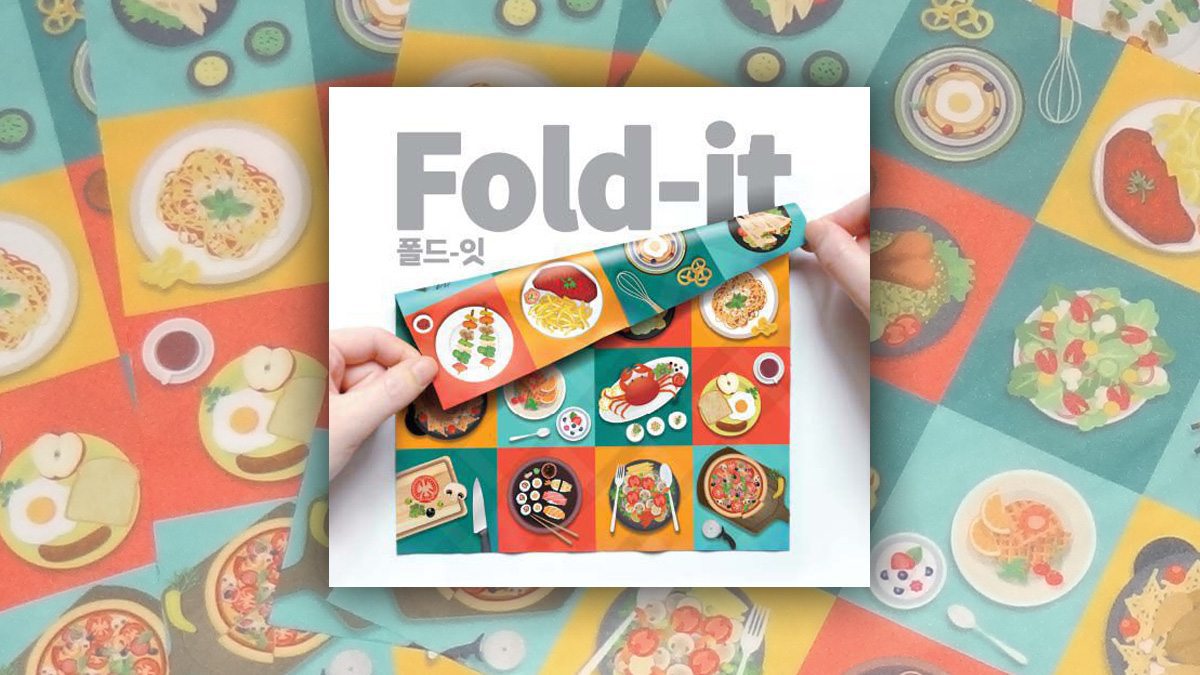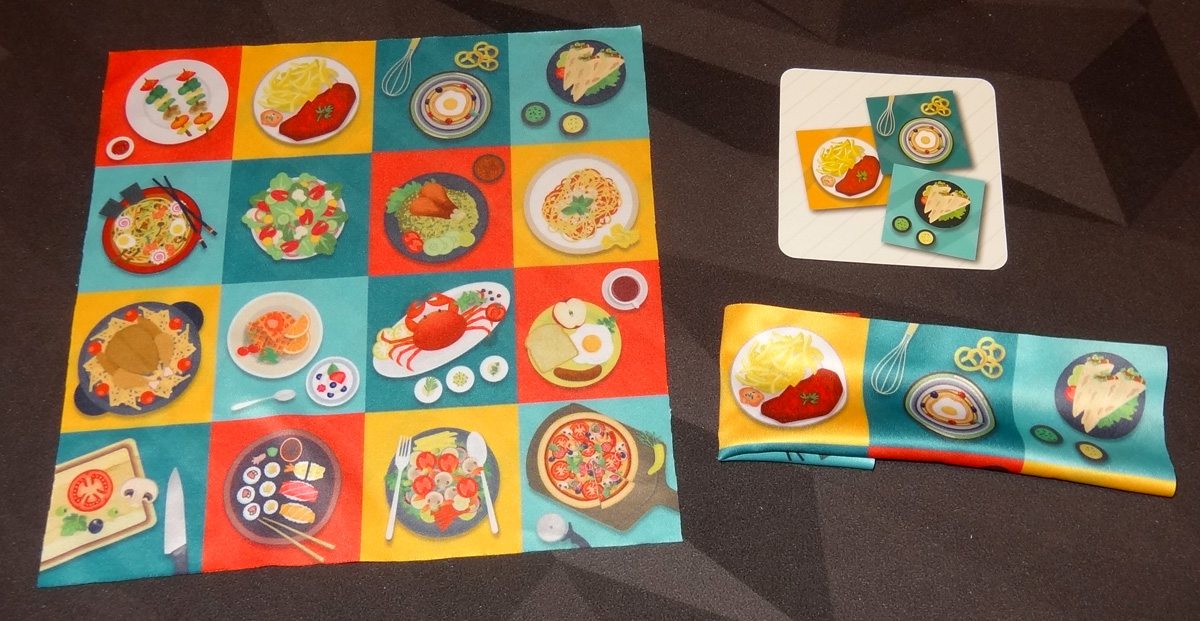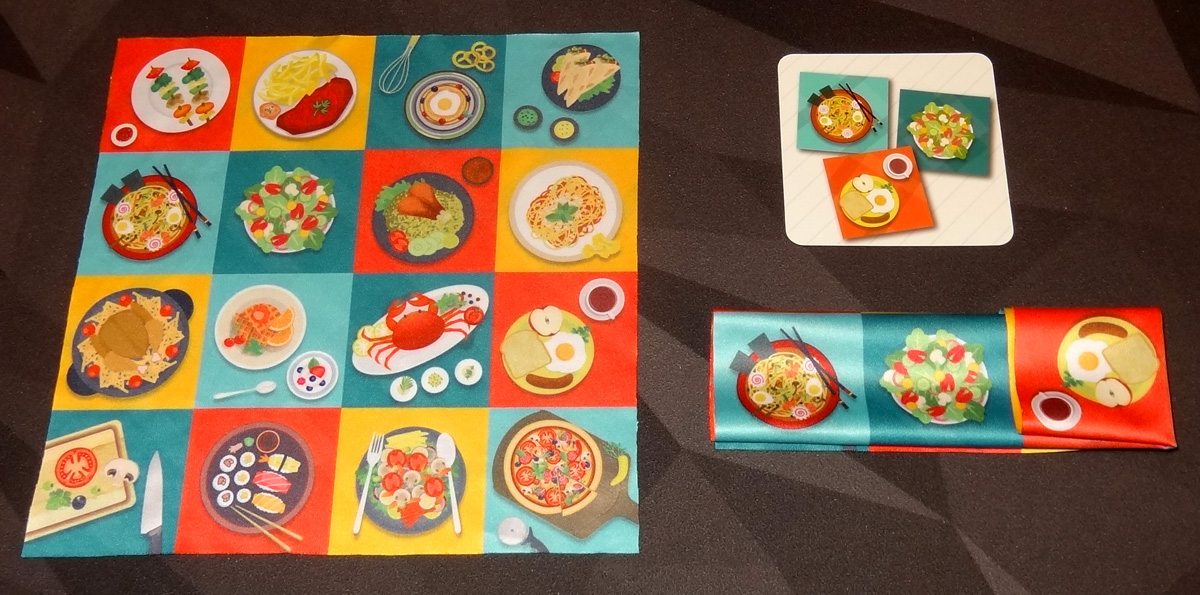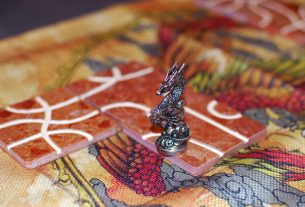 Fold-it combines the speedy observation skills in games like Spot It! with a logic-based folding puzzle, and it makes for an experience not quite like any game you’ve ever played.
Fold-it combines the speedy observation skills in games like Spot It! with a logic-based folding puzzle, and it makes for an experience not quite like any game you’ve ever played.
What Is Fold-it?
Fold-it is a game for 2 to 4 players, ages 7 and up, and takes about 20 minutes to play. It was originally published in 2016 by Korean publisher Happy Baobab; ThinkFun released an English-only version in the fall of 2017. It retails for $17.99 and is available in stores and from online retailers like Amazon or directly from ThinkFun. The game is appropriate both thematically and in complexity for just about any age, though it particularly rewards those who can handle the mix of dexterity and quick observation.

Fold-it Components
Fold-it comes with:
- 4 Recipe cloths
- 22 Basic Order cards
- 20 Advanced Order cards
- 3 Fold-it tokens
- 12 Star tokens
The list of components is fairly short, and most of them are fairly conventional sorts of bits: the tokens are simple round cardboard tokens, some larger with the word “Fold-it” printed on them, and some smaller with stars printed on them. The cards are square, about coaster-sized, in a medium quality cardstock. The basic cards show a blue checked cloth on the backs and the advanced cards show a red-and-orange checked cloth.
But then there’s the recipe cloths, which are a soft, silk-like material printed with a vibrant grid of 16 different dishes. The cloth is double-sided, so that the images match on the front and back of the cloth. The dishes are all unique, but are in the same style with similar colors, so that it can take a little bit of searching to find any particular dish. There are four different colored backgrounds used, though I wish there was a little little more variation used because the light blue and dark blue are fairly similar.

How to Play Fold-it
You can download a copy of the rulebook here.
The Goal
The goal of the game is to be the last player with star tokens left.
Setup
Give each player a recipe cloth and three star tokens. Place the Fold-it tokens in the center of the table, using one fewer than the number of players. Decide whether to use basic or advanced order cards, and shuffle the corresponding deck.
Gameplay
All players lay their recipe cloths flat on the table. The top card of the order deck is flipped over, revealing anywhere from 1 to 4 dishes.
All players play simultaneously, folding their recipe cloths so that only the dishes pictured on the order card are visible. The cloths may only be folded along the grid lines.

As soon as you have finished folding your cloth, take a Fold-it token from the center of the table. As soon as the tokens are gone, the player who did not get a Fold-it token must discard one star token. Then, everyone should check over the folded cloths: if you grabbed a Fold-it token but your cloth does not correctly show the dishes on the order card, you also discard a star token.
Then, unfold all the cloths, return the Fold-it tokens to the center of the table, and flip a new order card.
Game End
When a player runs out of star tokens, they are eliminated from the game, and one Fold-it token is returned to the box.
If you are the last player with star tokens left you win the game!

Why You Should Play Fold-it
Fold-it is a wacky concept with a theme shoehorned onto it, but it’s entertaining nonetheless. The “story,” if you want to call it that, is that you’re competing chefs, racing to cook up orders. I suppose it must be a cooking show, because otherwise I’m not sure why multiple people would be cooking the same order. It’s not really about how well you make the dishes, either: each dish you make will turn out perfectly. The real issue is whether you make the correct dishes and how quickly you make them. Okay, so it’s sort of a mechanic in search of a theme—that’s all right. So was Dominion, really.
But let’s take a closer look at that gameplay. The game is a real-time race to complete the order, and the first half of that is simply finding the necessary dishes on your recipe cloth. All four of the cloths are identical so everyone is looking at the same field of colorful plates and bowls. That also means that you get quicker with experience. When you first start playing the game, you have no idea where anything is, and you’ll spend precious seconds scanning your cloth for the pictured dishes. (Hint: use the background colors to narrow your field of search!)

The second half, of course, is actually folding the cloth. This requires both logic, to figure out which folds to make, and dexterity, in order to complete those folds before time runs out. On the easier cards, the foods are usually grouped in ways that make it fairly easy to figure out the folds, and so it’s mostly a matter of finding the dishes and completing the folds. For the advanced cards, the selections often force you to stop and think, and it may take you a couple tries to get something to fold properly. For instance, in the card pictured above, you somehow need to get the breakfast plate next to the ramen and salad (which are already next to each other). Can you figure it out?
Many of the orders will require you to use both sides of the cloth, and the order of the folds becomes crucial as you tuck away all the other dishes so they can’t be seen. The fabric is very soft and folds easily, but it’s also slippery and floppy, so picking up a folded cloth and flipping it over to its other side can often be difficult. I can see that this game would be frustrating to play if you don’t have nimble fingers.
Fold-it is definitely a skill-based game rather than a luck-based game. Each player starts in the same, unfolded state, and has equal access to the information presented. If you win, it’s because you found the dishes and folded the cloth most efficiently. There’s not a whole lot of luck involved. That also means you get better with practice, and experienced players may have a significant advantage over newer players. If you prefer games with a bit more random chance, Fold-it might not be a great fit.
I’ve been enjoying Fold-it: like many of ThinkFun’s products, it’s a puzzle game, except this time you get to compete with other players who are solving the same puzzle. I enjoy the advanced cards more, because those feel like they’re more about figuring out the puzzle rather than just finding the dishes before everyone else does. But I may need to figure out a sort of handicap system, whether that’s starting with fewer star tokens or giving my kids a few seconds’ head start on folding, because they’ve decided they don’t really want to compete with me.
If you like puzzle games, Fold-it provides a unique type of problem for you to solve.
Click here to see all our tabletop game reviews.
If you’d like to stay up-to-date with all of our tabletop gaming coverage, please copy this link and add it to your RSS reader.
Disclosure: GeekDad received a copy of this game for review purposes.




